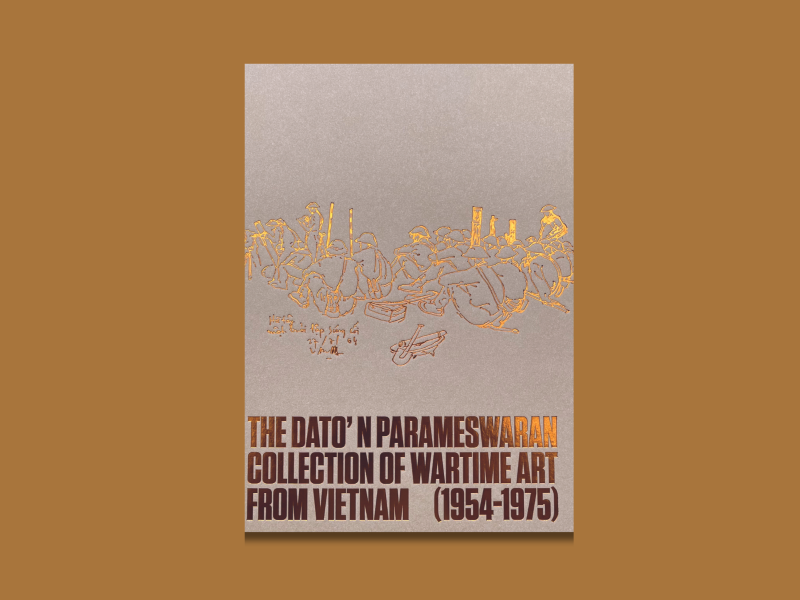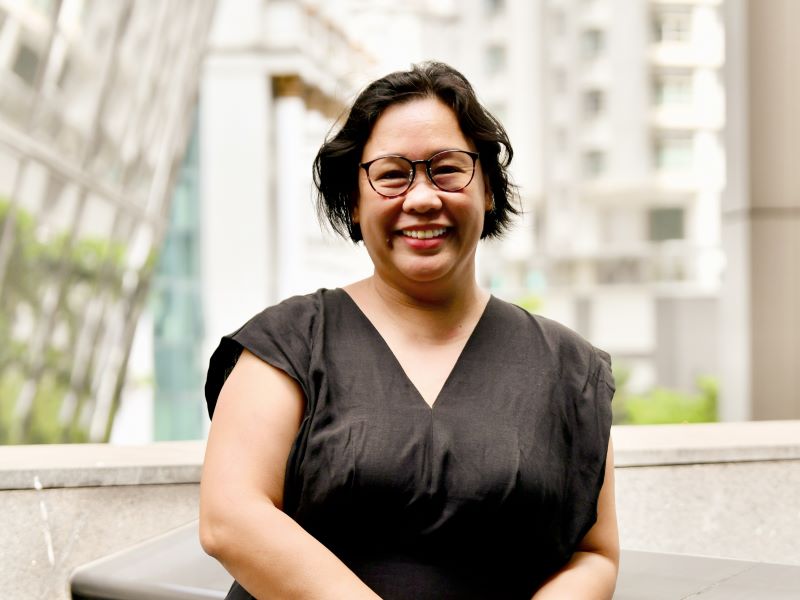
Sharmin Parameswaran (left) intends for her father Datuk Param’s art legacy to move on to where it will resonate most (Photo: Sam Fong/The Edge)
Who wants to remember a war? The National University of Singapore (NUS) Museum posed this question at an exhibition in 2016 and returns to it with The Dato’ N Parameswaran Collection of Wartime Art from Vietnam (1954-1975). Chang Yueh-Siang, who curated the show then and led the recent publication of the book, gave a talk on this subject with the collector’s daughter, Sharmin Parameswaran, at Ilham Gallery, Kuala Lumpur, on June 23.
“What I was trying to uncover was not so much why it was important to remember a war but the nature of memory and commemoration — how different people remember it differently, the diversity of wartime and personal memories, the sentiments of those on the losing side, and the experiences kept by people who had gone through war so that lessons we learn from it do not become reduced to nationalistic slogans and clichés.
“I wanted to make that distinction between this and official commemorations. Certainly, governments would want to ‘remember’ and mark victory and major events, but what is the purpose of this?”
Perak-born Datuk Param (1948-2022), as he was known, joined the foreign service in 1969 and served as Malaysia’s ambassador to Vietnam from 1990 to 1993, a time when the country was embarking on economic reform and becoming more open to the world. Its art scene was emerging and he met many artists, which sparked his interest in wartime art. Hence the start of his collection, which now belongs to Sharmin.
Param was Malaysian High Commissioner to Singapore from 2003 to 2008, the year he retired from the foreign service. Christine Khor, then director of NUS Museum, and current head Ahmad Mashadi knew him personally and learnt about the 1,230 works he had amassed. They proposed a long-term loan “to demonstrate through our exhibitions and module collaborations what a university museum can do with a collection such as this”, Chang says.
untitled_design_10.png

The loan was sealed in 2015 and the museum has used the valuable trove of posters, drawings and paintings, including descriptions of the artists, titles and the materiality of the works, in 38 NUS courses since. The collection was the subject of three exhibitions: Vietnam 1954-1975, the two-module Lines and Who Wants to Remember a War, and Wartime Artists of Vietnam.
“It was agreed with Datuk Param that when we came towards the end of the loan period, we would produce a book as a record of the projects it had made possible. We are also working on developing a story map where we try to locate the artworks geographically, with the hope that this will help us identify new patterns of understanding the movement of artists during the war.”
The publication provides a glimpse into the lives of the Vietnamese people in their journey towards decolonisation and independence. It is a portrayal of soldiers as actors in the war and the significance of the Ho Chi Minh Trail. From fighting against French colonialism to American intervention, it sheds light on the sociopolitical contexts, cultural narratives and artistic techniques prevalent throughout the Vietnam War, adds Chang, who includes an essay proposing some avenues of research and questioning that can continue to be undertaken with this collection, arranged in nine sections in the book: Posters and magazine covers, Portraits and life drawings, Prisoners of war, Wartime activities, Ethnic minority participants in the war, The Truong Son Trail (Ho Chi Minh Trail), Laos and Cambodia, Landscapes and battle scenes, and Military equipment.
One can definitely trace landmark events in the artworks, she says: Resistance against the French culminating in the Battle of Dien Bien Phu; the war against the Americans and efforts to reunite Vietnam; continued conflict in Cambodia until the 1980s, economic building and post-war reconstruction from the 1970s, and the Doi Moi Policies of 1986 to the 1990s.
“Beyond the more apparently propagandistic works, however, portraits drawn by the artists give us a closer look at the different individuals — highland minorities and French-overseas soldiers, for example — who participated in the war, or ordinary Vietnamese landscapes depicting the normality of life behind the frontlines. These pieces break the stereotypical expectations one might have of ‘wartime art’, and humanise the experience during the belligerent years.
20240623_peo_chang_yueh_siang_vietnam_wartime_2_sam.jpg

“What was foremost on my mind was to try to open up the ways of thinking about Vietnam war art, beyond it being just historical records of a past event. Who are the participants we do not know much about but should not forget? What are the questions we have not yet asked, beyond military history?”
The collection has nearly 800 sketches and drawings, made on the move, often very quick lines to capture an imagery. Having come out of French (and Soviet) training, sketching was a fundamental habit that most of the artists had; it was instinctive.
“The job of frontline artists was to draw, for communication or leisure, and they really had freedom to do whatever they wanted, whenever they wanted. That was how they continued to produce the number of artworks they did,” says Chang.
She did an interview with Param that Sharmin shares excerpts of, using his own words as he was “quite a storyteller”, on how he acquired the posters and drawings in his possession.
“There were no galleries then of the kind we know about today. What they had were exhibitions quite frequently, in one of the main roads in Hanoi, called Trang Tien Street... Most of my art was bought directly from the artists whom I used to meet very often in Hanoi, Ho Chi Minh City, Danang, Hue and other parts of Vietnam. I spent hours and hours with these artists and got to know them well.
“Once you got to know about an artist, you ask people where the guy lives, then go and see him, and find out more about him. One could buy art directly from the artists (if you pursued them and if they were interested to sell). I also went to the Hanoi School of Fine Arts where there are professors whom others had recommended. .. None of these war paintings, none of these posters, nothing from the war was bought from galleries, in this collection.”
annex_a_trong_kiem_long_bien_bridge_hanoi_1956_watercolour_on_paper_36_x_50_cm.jpg

Chang remembers Param as being very warm, enthusiastic and supportive. “I think he was happy to be working with us and genuinely enjoyed the fact that his collection was not just being exhibited but also used in teaching. Having his recollections and insights was also very useful to understand the context under which he collected these works.”
Sharmin says her father, “a very meticulous man”, made notes, kept newspaper cuttings and compiled folders and publications on each artist he was interested in.
“He also kept abreast of the current value of artworks, seeking and collecting gallery catalogues, attending auctions and taking note of the movement of prices. I think he was aware of both the academic or intrinsic and market value of his [pieces] and would make informed decisions based on that.”
Inheriting his artworks has been daunting and exciting, the oscillation “an ongoing process”. Two years after his passing, she is still going through the collection and attempting to understand what everything meant to him, why he collected and documented, and his intentions for each piece and the whole lot.
“What did he want all of this to amount to and for whom?” While she ponders on that, Sharmin knows she wants her father’s legacy to move on to “where it would resonate most, and be best appreciated. But I’ll need to do my own homework on where this is, and to then make the necessary informed decisions”.
The Dato’ N Parameswaran Collection of Wartime Art from Vietnam (1954-1975), (RM630) and Wartime Artists of Vietnam: Drawings and Posters from the Ambassador Dato’ N Parameswaran Collection (RM100) are available at Ilham Gallery, KL (ilhamgallery.com)
This article first appeared on Jul 1, 2024 in The Edge Malaysia.


